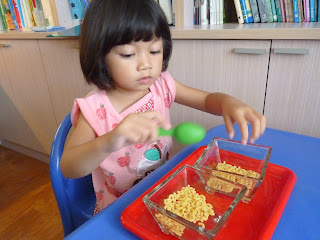Quite a few people have asked me lately about teaching a preschooler at home - how do I do it?
I decided to share a series of short posts about the first steps in homeschooling a 3-year-old.
It is a third child of this age that I will be teaching at home and by now I have most of the materials already prepared. This makes a big difference as I don't have to spend much time searching, printing, writing, cutting and laminating many of the materials I need to use, I just take them out of the storage, find a place on a shelf and voila! the material is ready.
Materials:
Remember to tell your child that he is not supposed to eat the 'work'! Ania kept repeating to herself:麵還沒有煮好 - pasta is not cooked.
I decided to share a series of short posts about the first steps in homeschooling a 3-year-old.
It is a third child of this age that I will be teaching at home and by now I have most of the materials already prepared. This makes a big difference as I don't have to spend much time searching, printing, writing, cutting and laminating many of the materials I need to use, I just take them out of the storage, find a place on a shelf and voila! the material is ready.
First Practical Life exercise I want to show you is
spooning pasta.
spooning pasta.
Materials:
- tray
- two identical bowls
- spoon
- fine uncooked pasta
Remember to tell your child that he is not supposed to eat the 'work'! Ania kept repeating to herself:麵還沒有煮好 - pasta is not cooked.
 |
| Carrying the work to the table is not an easy task (as you will see later). |
 |
| Tilting the bowl a bit to get all the pasta into the spoon... |
 |
| ... or simply pouring the last bits of pasta from one bowl to the other. |
 |
| Oh-oh! The tray tipped over and ... all the pasta spilled on the floor. Now it's time to clean it all up. |


Comments
Post a Comment